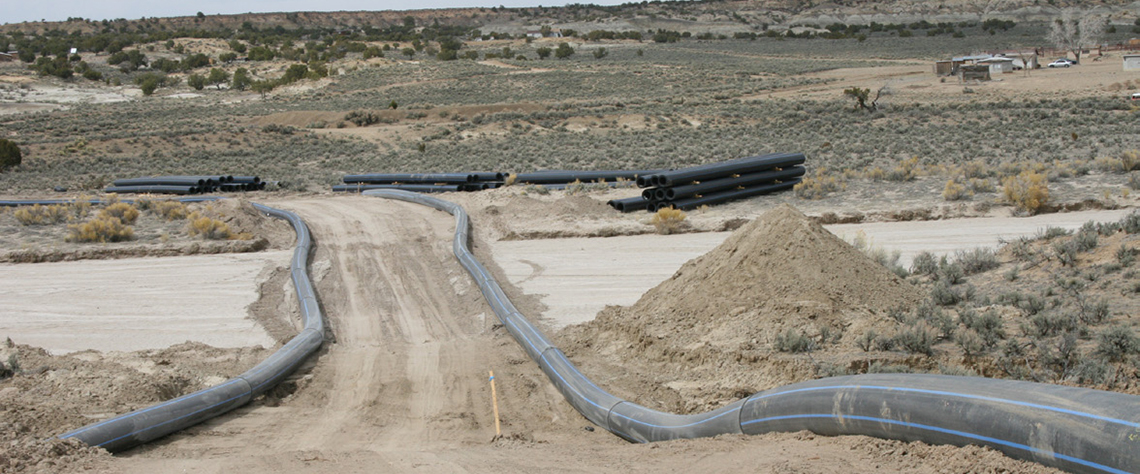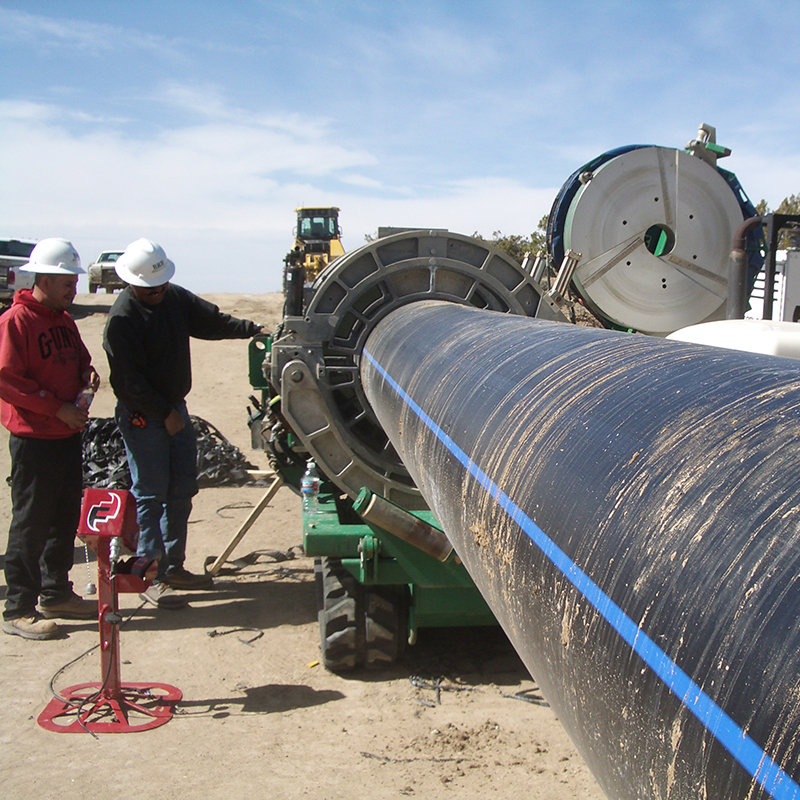
Access to adequate water has historically been an issue in Navajo reservations in the Southwest. In recent years, projects have begun to provide water access for the Navajo people. One project involves the Eastern Navajo Water Pipeline, which consists of four phases. The pipeline is owned by the Navajo Nation. This field report represents phase two of the water pipeline project that runs from Nageezi, NM to Counselor, NM. Phase two of the pipelines consists of 13 miles of high-density polyethylene (HDPE) pipe.
The complete four phase pipeline project will provide a sustainable water supply to 10,000 people across four counties and eight Navajo chapters. Of the 10,000, nearly 4,000 people currently do not have running water in their homes. These families haul water to their homes in trucks or by horse back. In addition, many of the water sources used by these water haulers are not fit for human consumption due to bacterial contamination.
“It is very emotional for me to see this happening,” said Navajo Counselor Chapter President Samuel Sage at the dedication ceremony on Monday. “We will have a lot of people that will get water they can actually drink.”
Funding for the four phases of the project has come from many sources including the United States Department of Agriculture (USDA), State of New Mexico, Navajo Nation, Indian Health Service (IHS) and individual Navajo Chapters, totaling more than $28 million.
Out of the more than $28 million in funds provided for the four phase project, phase two received $8 million from the USDA, $1 million from the State of New Mexico and $160,000 from individual Navajo Chapters, according to the USDA.

HDPE Pipe for Corrosive Soil Conditions
Originally, the project design for phase two included using 10 miles of ductile iron pipe and three miles of PVC, but the soils in the area were found to be aggressive. Therefore, Senior Engineer Andrew Robertson, P.E. of Souder, Miller & Associates (SMA) decided to use HDPE for phase two of the project. SMA is the engineering firm responsible for phases two, three and four of the pipeline project.
“We chose to use HDPE in the phase two design because there was a concern regarding the potential corrosive nature of the soil in the area that precluded us from using ductile iron pipe,” said Robertson.
In addition, Robertson noted that it was difficult to get both the pressure rating and size needed for the phase two area with PVC, but it was possible with PE 4710 resin-based HDPE pipe for water applications.

The ISCO Solution
The contractor chosen for phase two was BRB Contractors. The Topeka, KS-based BRB Contractors contacted ISCO to supply very heavy wall and high pressure (PE 4710 resin) 24-inch DR 7.3 and DR 9 HDPE pipe as well as fabricated pipe fittings.
In addition to being corrosion resistant, HDPE was also ideal for phase two because of its flexibility. The flexibility of HDPE pipe allows it to curve and bend along with the rolling terrain characteristic of the area between Nageezi and Counselor. The pipe’s flexibility also reduced the number of pipe fittings needed on the job, saving the project money.
HDPE is also more resistant to water hammer because it is more elastic and absorbs the pressure. SMA analyzed the potential for water hammer in phase two and noted that if there was a power failure, the water in the pipe could go from 3,000 gallons per minute (GPM) to zero GPM in a short amount of time, creating a pressure surge. HDPE can withstand such a surge more easily than other types of pipe.
ISCO Industries also supplied McElroy fusion equipment to join the pipe. ISCO carries one of the largest fleets of McElroy fusion machines. Once HDPE pipe is fused together, it becomes one continuous length of pipe. The fused ends become as strong as or stronger than the HDPE pipe itself.
Currently, BRB Contractors is fusing the sections of HDPE pipe and will begin installing the pipe using an open trench method. According to BRB Contractors, the open trench method was the most cost-effective method for the pipeline installation given the type of terrain encountered in phase two. In some areas of the project, BRB Contractors will use a boring technique to avoid open trenching of natural obstacles.
The HDPE pipe is first fused above ground and then installed inside the trench. The valves required for the pipeline will be assembled and installed prior to insertion of the pipeline into the trench, except at the bore sites.
“HDPE is really the best pipe for this project,” said Dan Welch of BRB Contractors. “It has strength greater than PVC pipe as well as better flexibility than DIP. With the elevation changes throughout the project site, the strength and flexibility of HDPE, along with the joint fusion, make this pipe more reliable and will require less future maintenance than other piping choices.”
SUBSCRIBE TO ISCO UPDATES
ISCO Updates
[gravityform id="21" title="true"]
